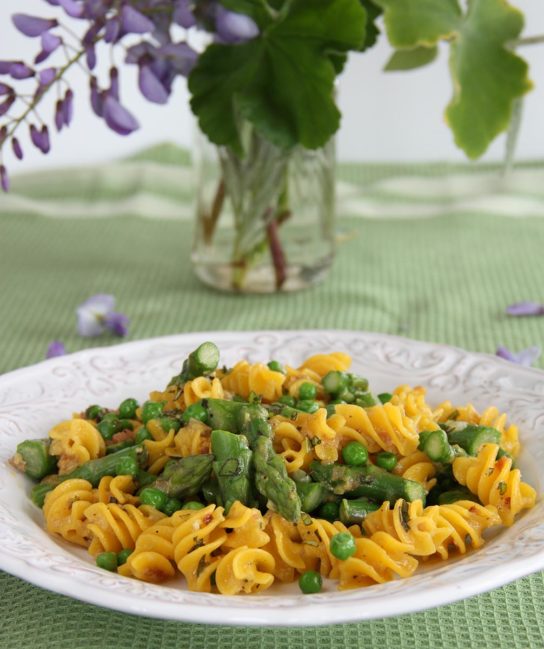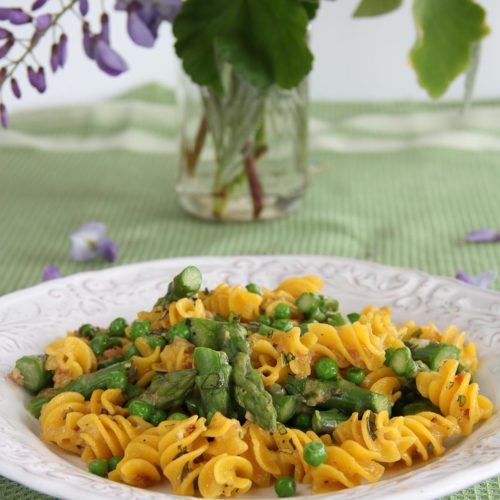 I was not going to give up pasta when I had to stop eating wheat, so I went on a search for a tasty, firm, nutritious, gluten-free product. Most gluten-free pastas are made from rice. The texture and flavor of rice-based noodles are great in Asian cooking, but they don’t work for me in Italian food—they don’t have enough body, easily overcook to a limp mess, and the flavor is wrong. In addition, it is now suggested we cut back on rice consumption, because of high arsenic levels in some rice products.
I was not going to give up pasta when I had to stop eating wheat, so I went on a search for a tasty, firm, nutritious, gluten-free product. Most gluten-free pastas are made from rice. The texture and flavor of rice-based noodles are great in Asian cooking, but they don’t work for me in Italian food—they don’t have enough body, easily overcook to a limp mess, and the flavor is wrong. In addition, it is now suggested we cut back on rice consumption, because of high arsenic levels in some rice products.
Ancient Harvest Quinoa Pasta and Schar Gluten-Free Pasta are two happy discoveries. They are both a semolina-like yellow from the corn in their formula, taste pleasantly nutty, and are resilient in texture if not overcooked. Ancient Harvest is organic and adds quinoa for rich flavor, high quality protein, iron, and B vitamins. Schar incorporates pea protein and rice flour for a more complex taste and extra protein.
Pasta Update: Since writing this post in 2013, I have discovered 2 new pastas. Barilla has developed excellent gluten-free pastas, made from corn flour and rice flour. They come the closest to traditional pasta in both flavor and texture. I am also a fan of Power Pasta, fashioned from red lentils. Although not as similar to wheat pasta as Barilla, this pasta is wonderfully satisfying because it is a whole food packed with protein, vitamins and minerals. Read more about it here, where you will also find another recipe featuring asparagus.
I love pasta carbonara almost as much as the New Yorker writer and food enthusiast Calvin Trillin does. While I don’t follow his suggestion to serve it for Thanksgiving dinner, I make it frequently, and in many guises. Inspired by the fresh asparagus and peas appearing now in farmers’ markets and grocery stores, I prepared the recipe here for lunch this past weekend. To compliment the spring vegetables, I added lemon zest and fresh basil to the egg, pancetta, and Parmesan cheese sauce.
In that I was straying from tradition with this recipe by the addition of vegetables, lemon, and basil, I made another change: I used rotelle in place of the customary spaghetti. The sauce got delightfully entwined in the little squiggles, and the squat shape is a great match for asparagus.
Gluten-free pastas need a little extra care when cooking. Use an abundant amount of boiling salted water, and be certain to stir frequently, otherwise the pasta tends to stick together—especially true for long, thin strands such as linguine and spaghetti. Finally, drain when the pasta is still slightly crunchy in the center, because it will soften too much if even a tad overcooked. I start checking the pasta at the shorter time suggested on the package, and generally cook about 1 minute longer.
Make a fine spring meal with this recipe, and see just how good gluten-free pasta can be.

Pasta Carbonara with Asparagus and Peas
Kristine KiddIngredients
- 1 tablespoon olive oil
- 1½ oz pancetta, chopped
- 1 shallot, minced
- ¾-1 lb asparagus, trimmed, cut into 1-inch pieces
- 1 cup shelled fresh peas or frozen, do nor thaw
- 5 oz gluten-free rotini, rotelle, or fusilli pasta
- 2 large eggs
- ¾ cup freshly grated Parmesan cheese
- ½ teaspoon finely grated lemon zest
- Freshly ground black pepper
- ¼ cup dry white wine
- 2 tablespoons chopped fresh basil
- Coarse kosher salt
Instructions
- Place a large nonstick skillet over medium-high heat. Add the pancetta and sauté until beginning to brown, about 3 minutes. Add the shallot and sauté until tender, about 2 minutes. Remove the skillet from the heat.
- Bring a large pot three-fourths full of salted water to a boil. Add the asparagus and cook 3 minutes. Add the peas and cook until the vegetables are almost tender, about 1½ minutes longer. Using a slotted spoon, transfer the vegetables to a bowl and rinse with cold water to stop the cooking. Drain in a colander and leave in the colander. Add the pasta to the pot and stir well. Cook until the pasta is al dente, stirring frequently, about 7 minutes.
- Meanwhile, break the eggs into a small bowl, and beat with a fork. Mix in the cheese, lemon zest, and a generous amount of black pepper.
- Remove ⅔ cup of the pasta cooking water and reserve. Drain the pasta in the colander with the vegetables. Add the wine to the skillet and boil until reduced by half, stirring up the browned bits, about 1 minute. Remove the pan from the heat. Add the pasta and vegetables to the skillet. Gradually whisk ⅓ cup of the reserved pasta cooking liquid into the egg mixture. Add the egg mixture to the frying pan and toss until it coats the pasta and vegetables and is creamy, not wet and runny. If the egg mixture does not become creamy, set the skillet over very low heat and stir constantly just until it becomes creamy, watching carefully (do not boil). Immediately remove the pan from the heat. If needed, mix in enough of the remaining ⅓ cup pasta cooking liquid to form a silky texture. Mix in the basil and season to taste with salt and pepper.
- Divide the pasta and vegetables between 2 warmed plates and serve right away.
2 thoughts on “Gluten-Free Pasta<br>Pasta Carbonara with Asparagus and Peas”
I think this sounds great, and I have both asparagus and fresh peas in my fridge!
Thank you, Betty. I hope you enjoy it as much as we did.